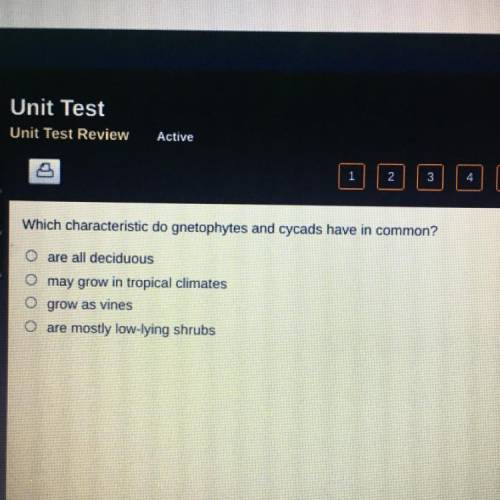Which characteristic do gnetophytes and cycads have in common?
O are all deciduous
may grow i...

Biology, 27.10.2020 20:10 abigail2403
Which characteristic do gnetophytes and cycads have in common?
O are all deciduous
may grow in tropical climates
O grow as vines
are mostly low-lying shrubs


Answers: 2


Another question on Biology

Biology, 21.06.2019 20:30
Will mark brainliest if correct/available! which of the following statements is true? all plants need flowers to sexually reproduce. sexually reproduced offspring are identical to their parents. fertilization always occurs inside the female's body. a body cell has twice the number of chromosomes as an egg cell.
Answers: 1

Biology, 22.06.2019 02:30
Part e - sequence of metabolic processes each of the different cellular metabolic pathways occurs in a specific order. consider aerobic cellular metabolism from the beginning to end. what is the sequential order of the metabolic processes that starts with glucose and results in the production of carbon dioxide, water, and atp? put the following in the correct sequential order. rank from earliest to latest. to rank items as equivalent, overlap them. view available hint(s) acetyl coaglycolysiscitric acid cycle pyruvate finishstartstart background image electron transport chain background image finish background image submit cellular metabolism is often expressed as an equation. this equation puts into perspective, on a general scale, the substances needed to start cellular metabolism and the products that come out of it. the equation represents the overall product yield after every step of cellular metabolism is complete (i.e., glycolysis through the electron transport system). in this part of the tutorial you task will be to put together the equation that represents cellular metabolism. you will also learn the products that result from each metabolic pathway and the role that some these products play in the production of atp.
Answers: 2

Biology, 22.06.2019 06:50
The kidney filters potentially toxic substances in the blood, and thus “clears” the blood of those substances. this clearance function is dependent upon and proportional to the diffusion gradient of the substance across filtering capillaries, i.e. if the concentration of the substance is doubled, twice as much will be cleared from each ml of blood that is filtered. suppose that the body produces a constant amount of a substance x per unit of time. the kidneys eliminate substance x at a rate directly proportional to the concentration of the substance and the volume of blood cleared each minute (c): elimination = c × [x], where [x] is the steady-state concentration of substance x. imagine an individual with an initial concentration of x equal to [x]0 who develops kidney disease. her baseline clearance c0 drops to one half of the original (½c0). what is the new steady state concentration of x? (for simplicity, assume that substance x is 100% filtered by the kidney).
Answers: 1

Biology, 22.06.2019 07:30
Cathy hypothesized that corn would not grow in mud. to test this hypothesis, she took corn kernels and placed 5 in mud, 3 in soil, and 2 in water. to her surprise, the kernels in the mud grew faster than the kernels in the soil. what error might have caused these unexpected results? a. wrong hypothesis b. not enough variables c. undefined control d. too many variables
Answers: 3
You know the right answer?
Questions

English, 20.12.2019 10:31

Mathematics, 20.12.2019 10:31




Medicine, 20.12.2019 10:31

Mathematics, 20.12.2019 10:31




Mathematics, 20.12.2019 10:31


Chemistry, 20.12.2019 10:31




Biology, 20.12.2019 10:31

Computers and Technology, 20.12.2019 10:31


English, 20.12.2019 10:31



